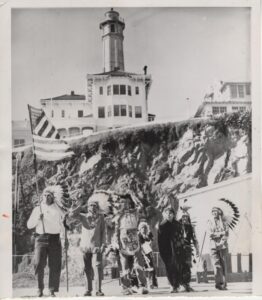Indians of All Tribes
ON VIEW: September–December 2025
Kirby Art Study Center · 317 Hamilton Street
Indians of All Tribes: Decolonizing Democracy and the Politics of Indigenous Resistance
This expanded exhibition presents the Goodman Collection’s comprehensive documentation of pivotal Native American activism spanning nearly two decades of resistance and cultural reclamation. While anchored by powerful photographs from the historic Alcatraz Island occupation (November 1969–June 1971) by Indians of All Tribes, the collection extends far beyond this landmark event to chronicle the broader Red Power movement that transformed Indigenous rights in the United States.

photograph, March 2, 1964, Vintage Associated Press wirephoto
The exhibition captures the 71-day occupation of Wounded Knee, South Dakota (1973), where 200 Oglala Lakota and American Indian Movement (AIM) members protested corrupt reservation leadership. Vintage wire service photographs document armed patrols on horseback, tense negotiations in traditional tipis, and the daily life of occupiers who galvanized Indigenous youth nationwide. Key AIM leaders Dennis Banks and Russell Means appear alongside traditional chiefs like Tom Bad Cob, illustrating the alliance between contemporary activists and tribal elders.
Additional documentation includes the Menominee Warrior Society’s 34-day standoff in Wisconsin (1975), the week-long takeover of the Bureau of Indian Affairs building in Washington, D.C. (1972), and protests from Chicago’s Uptown area to Seattle’s Fort Lawton. These images reveal how Native activists strategically employed both ancestral traditions—such as ceremonial drums, warrior regalia, and sacred symbols—and modern media tactics to challenge federal policies.
The photographs also expose government surveillance and infiltration efforts, including revelations about FBI operative Douglass Durham, who served as AIM’s security chief while secretly reporting to federal authorities. This documentation of state oppression adds crucial context to understanding the risks these activists faced.
Throughout the collection, the upside-down American flag appears repeatedly as a distress signal, symbolizing how Native Americans used patriotic imagery to highlight the nation’s failure to honor treaty obligations. From the symbolic “discovery” of Italy by Chippewa leader Adam Nordwall to protests demanding the return of ancestral lands in Washington State, these images document a movement that challenged America’s foundational narratives.
As we approach the 250th anniversary of the Declaration of Independence, these photographs compel viewers to reconsider the status of Indigenous communities against the backdrop of broken promises, breached contracts, and continued colonization. The exhibition reveals how Native Americans fought not only for political rights but for cultural survival, using photography itself as a weapon in their struggle for recognition, sovereignty, and justice.
This visual chronicle demonstrates that the Alcatraz occupation was not an isolated event but part of a sustained, nationwide movement that forever changed the relationship between Indigenous peoples and the United States government.